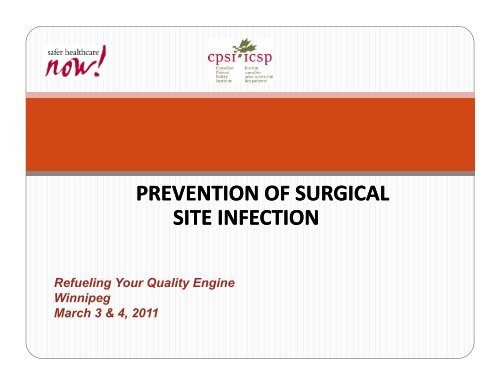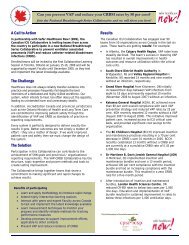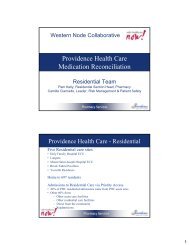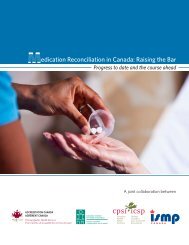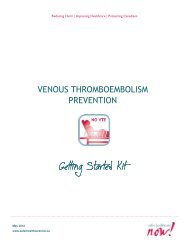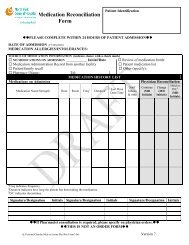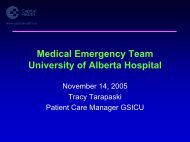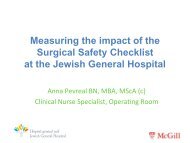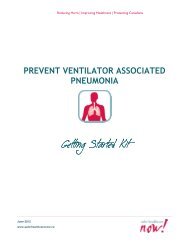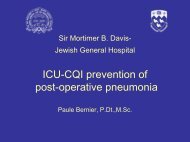Surgical Site Infection and the Operating Room Checklist - Safer ...
Surgical Site Infection and the Operating Room Checklist - Safer ...
Surgical Site Infection and the Operating Room Checklist - Safer ...
You also want an ePaper? Increase the reach of your titles
YUMPU automatically turns print PDFs into web optimized ePapers that Google loves.
PREVENTION OF SURGICAL<br />
SITE INFECTION<br />
Refueling Your Quality Engine<br />
Winnipeg<br />
March 3 & 4, 2011
Risk Factors for SSI<br />
Patient Operation Post-op care<br />
Age Antimicrobial prophylaxis p Wound care<br />
Nutritional status<br />
Blood Glucose<br />
Discharge<br />
Diabetes<br />
Smoking<br />
Obesity<br />
Steroid use<br />
Normo<strong>the</strong>rmia<br />
Hair Removal<br />
Antiseptic technique<br />
<strong>Surgical</strong> technique<br />
Prolonged pre-op LOS Wound classification<br />
Length of surgery<br />
Blood transfusion<br />
OR Ventilation<br />
Traffic Control
Prophylactic Antibiotics
Appropriate Use Of Antibiotics<br />
• The right drug<br />
• The right dose<br />
• At <strong>the</strong> right time*<br />
• For <strong>the</strong> right duration<br />
Performance e measure (target):<br />
• % surgical patients given pre-op ABx within 60 min*<br />
(Goal ≥ 95% )<br />
• % surgical patients having ABx , discontinued within<br />
24 hrs ( Goal ≥ 95% )
Duration Concerns<br />
• There is a lack of evidence that antibiotics given<br />
after <strong>the</strong> end of <strong>the</strong> operation prevent SSIs.<br />
• There is evidence that unnecessary or prolonged<br />
use of antibiotics promotes antibiotic resistance 1<br />
1. Bratzler & Houck. Clinical infectious Diseases 2004; 38: 1706-15
SHN! Recommendation 1<br />
• Based on <strong>the</strong> evidence, <strong>the</strong> <strong>Safer</strong> Healthcare Now! faculty<br />
recommend that prophylactic antibiotics be completely<br />
absorbed within 60 minutes of first incision, <strong>and</strong> should<br />
be repeated for surgeries lasting longer than <strong>the</strong> half-life life<br />
of <strong>the</strong> antibiotic (4 hours for cephalosporins).<br />
• Antibiotics administered for cardiac, thoracic,<br />
orthopaedic <strong>and</strong> vascular patients should be discontinued<br />
within 24 hours of <strong>the</strong> end of surgery, whereas noncomplex<br />
<strong>and</strong> uncomplicated surgeries require no fur<strong>the</strong>r<br />
administration of antibiotics following surgery.<br />
1. <strong>Safer</strong> Healthcare Now! Getting Started Kit: <strong>Surgical</strong> <strong>Site</strong> <strong>Infection</strong> Prevention, March 2010
Prophylaxis Dosing<br />
• Consider <strong>the</strong> upper range of doses for large<br />
patients<br />
- Gastroplasty: SSI rates 16.5% vs 5.6% 1<br />
• Repeat doses for long operations (> 4 hours)<br />
- Cardiac surgery: SSI rates 16% vs 7% 2<br />
1<br />
Forse, R; Karam, B; Maclean, D; Cristou, N. Antibiotic prophylaxis for surgery in morbidly obese patients. Surgery, 1989, 106: 750-7<br />
2<br />
Zanetti et al., Emerg Infect Dis, 2001
Weight Based Dosing in Canada:<br />
Evidence into Practice<br />
Healthcare Facility Cefazolin Vancomycin<br />
Fraser Health Authority, Vancouver,<br />
British Columbia<br />
Edmonton <strong>and</strong> Area Acute Care<br />
Facilities, Alberta Health Services,<br />
Alberta<br />
Grace Hospital, Winnipeg Regional<br />
Health Authority, Winnipeg,<br />
Manitoba<br />
University Health Network, Toronto,<br />
Ontario<br />
North York General Hospital,<br />
Toronto, Ontario<br />
Sunnybrook Health Sciences,<br />
Toronto, Ontario<br />
1g IV if ≤80kg<br />
2g IV if >80kg<br />
1g IV if ≤100kg<br />
2g IV >100kg<br />
1g IV if 80kg<br />
1g IV if ≤100kg<br />
2g IV >100kg<br />
Not Available<br />
Not Available
SHN! Recommendation<br />
• Based on <strong>the</strong> evidence, SHN Faculty recommends that<br />
prophylactic antibiotic administration be started <strong>and</strong><br />
completed within 60 min. of first incision for<br />
c-sections instead of after cord-clamping. clamping<br />
• Faculty recommend that prophylactic antibiotic<br />
• Faculty recommend that prophylactic antibiotic<br />
infusion be started <strong>and</strong> completed within 60 min. (120<br />
min. for Vancomycin) prior to application of<br />
tourniquet to maximize antibiotic efficacy.
Change Ideas<br />
Use pre-printed printed or computerized st<strong>and</strong>ing orders specifying choice of antibiotic,<br />
dose, timing, <strong>and</strong> discontinuation.<br />
Change operating room drug stocks to include only st<strong>and</strong>ard doses <strong>and</strong><br />
st<strong>and</strong>ard drugs, reflecting locally agreed upon guidelines.<br />
Incoporate pre-mixed antibiotics for use by OR staff.<br />
Reassign antibiotic administration responsibilities to anes<strong>the</strong>sia or holding area<br />
nurse to improve timeliness.<br />
I t th f th i l f t h kli t th t “A tibi ti b b d”<br />
Incorporate <strong>the</strong> use of <strong>the</strong> surgical safety checklist so that “Antibiotic absorbed”<br />
is addressed in <strong>the</strong> time out.
Hair Removal
SHN! Recommendation 1<br />
• Based on <strong>the</strong> evidence, <strong>the</strong> <strong>Safer</strong> Healthcare Now! SSI<br />
faculty recommend that patients be educated d not to<br />
shave in <strong>the</strong> vicinity of <strong>the</strong> incision for one week<br />
preoperatively.<br />
• No hair removal prior to surgery is optimal.<br />
• If hair removal is necessary, clippers should be used<br />
outside of <strong>the</strong> OR <strong>and</strong> within 2 hours of surgery.<br />
• Do not use razors in <strong>the</strong> vicinity of <strong>the</strong> surgical area.<br />
• Patients should shower after clipping due to increased risk<br />
of bacterial contamination of <strong>the</strong> surgical site.<br />
1. <strong>Safer</strong> Healthcare Now! Getting Started Kit: <strong>Surgical</strong> <strong>Site</strong> <strong>Infection</strong> Prevention, March 2010
Change Ideas<br />
• Develop a letter for surgeon’s offices to provide to<br />
<strong>the</strong>ir patients that includes a reminder about not<br />
shaving for one week prior to surgery<br />
I di t th t th li i f h i ill b d i<br />
• Indicate that <strong>the</strong> clipping of any hair will be done in<br />
<strong>the</strong> hospital on <strong>the</strong> day of surgery
Perioperative Normo<strong>the</strong>rmia
Consequences of Mild Hypo<strong>the</strong>rmia<br />
• Increases duration of hospitalization<br />
• Increases intra-operative blood loss<br />
• Increases adverse cardiac event<br />
• Increases patient shivering in PACU<br />
• Promotes metabolic acidosis<br />
• Increases SSI rates 1<br />
1. Melling et al. 2001 Lancet, 358: 876-80
SHN! Recommendation 1<br />
• Based on <strong>the</strong> evidence, <strong>the</strong> <strong>Safer</strong><br />
Healthcare Now! SSI faculty recommend<br />
that measures are taken to ensure that<br />
surgical patient core temperature<br />
remain between 36.0⁰C <strong>and</strong> 38⁰C<br />
preoperatively, intraoperatively, <strong>and</strong> in<br />
PACU.<br />
1. <strong>Safer</strong> Healthcare Now! Getting Started Kit: <strong>Surgical</strong> <strong>Site</strong> <strong>Infection</strong> Prevention, March 2010
Change Ideas<br />
• Pre operative warming utilizing forced warm air blankets<br />
for 30+ min pre-op<br />
• Continue active warming in <strong>the</strong> OR (include warmed IV<br />
fluid <strong>and</strong> lavage for abd. cases)<br />
• Increase <strong>the</strong> ambient temperature in <strong>the</strong> operating room<br />
to 20⁰C<br />
• Hats <strong>and</strong> booties on patients during surgery<br />
• PACU warming to discharge as needed<br />
• Do this routinely on all procedures slated 60 min. +
Blood Glucose Control
Recent Research<br />
• Strict t vs. conventional blood glucose control<br />
• 2009 consensus statement on glycemic control from<br />
• 2009 consensus statement on glycemic control from<br />
American Association of Clinical Endocrinologists <strong>and</strong><br />
American Diabetes Association report BG should be<br />
maintained between 7.8 <strong>and</strong> 10 mmol/L for most<br />
critically ill patients
SHN! Recommendation 1<br />
• Basedon<strong>the</strong>evidence evidence, The<strong>Safer</strong><br />
Healthcare Now! SSI faculty recommend<br />
that preoperative blood glucose levels be<br />
checked on all surgical patients. Teams<br />
are encouraged to apply glucose control<br />
to surgical populations as directed by<br />
your local organization.<br />
1. <strong>Safer</strong> Healthcare Now! Getting Started Kit: <strong>Surgical</strong> <strong>Site</strong> <strong>Infection</strong> Prevention, March 2010
Change Ideas<br />
• Pre-op blood sugar analysis to pick up on undiagnosed<br />
diabetics<br />
• Referral to endocrinology or initiate treatment prior to<br />
slated date
Skin Prep<br />
Prevention Strategies <strong>and</strong> Skin Antisepsis
The Ideal Skin Antimicrobial<br />
• The “ideal” antimicrobial agent for skin should<br />
have <strong>the</strong> following properties:<br />
- Broad spectrum<br />
- Rapid bactericidal activity<br />
- Persistence or residual properties on <strong>the</strong> skin<br />
- Effective in <strong>the</strong> presence of organic matter<br />
- Non-irritating or have low allergic <strong>and</strong>/or toxic responses<br />
- None or minimal systemic absorption
Current Approaches: Prevention of SSIs<br />
Multiple studies have shown that CHG <strong>and</strong> CHG/alcohol<br />
solutions display <strong>the</strong>se important properties:<br />
•CHG plus 70% isopropyl alcohol (IPA) has demonstrated<br />
efficacy against a wide range of bacteria, including P.<br />
aeruginosa, S. aureus, <strong>and</strong> antibiotic-resistant bacteria.<br />
•CHG/IPA exhibits a rapid onset of action, persists for up to<br />
24 hours, <strong>and</strong> has increased efficacy with repeated<br />
applications.<br />
•Chlorhexidine is not inactivated in <strong>the</strong> presence of blood,<br />
which neutralizes <strong>the</strong> effects of iodine <strong>and</strong> PCMX <strong>and</strong> dilutes<br />
<strong>the</strong> effects of alcohol.<br />
Florman et al. Current Approaches for <strong>the</strong> Prevention of SSIs. Am J Infect Dis. 3(1):51-61, 2007.
Safety<br />
• CHG 2%/70% IPA solution is flammable<br />
• CHG-alcohol skin prep solution should not be used<br />
around eyes, ears, <strong>and</strong> mouth, or come in direct<br />
contact with neural tissue
SHN! Recommendation 1<br />
• Based on <strong>the</strong> evidence, <strong>the</strong> <strong>Safer</strong> Healthcare Now! SSI faculty<br />
recommends that <strong>the</strong> skin should be cleansed before surgery<br />
with a chorhexidine–based solution, preferably with no rinse<br />
disposable chlorhexidine gluconate impregnated wash cloths.<br />
• The antiseptic of choice for skin prep should be alcohol based<br />
chlorhexidine antiseptic solutions instead of povidone-iodine.<br />
• Following application of chlorhexidine-alcohol skin prep<br />
solution, surgical teams should complete <strong>the</strong> time out of <strong>the</strong><br />
surgical checklist to allow time for <strong>the</strong> skin prep to dry.<br />
1. <strong>Safer</strong> Healthcare Now! Getting Started Kit: <strong>Surgical</strong> <strong>Site</strong> <strong>Infection</strong> Prevention, March 2010
SHN! Recommendation 1<br />
• To maximize its efficacy, CHG-alcohol skin prep should not be<br />
washed off for at least 6 hours following surgery.<br />
• In order to prevent a fire hazard, It is imperative that CHG-<br />
alcohol lskin prep be allowed to air dry for at least 3 minutes, or<br />
longer if <strong>the</strong>re is excessive hair insitu.<br />
• Povidone-iodine should be used as a skin preparation in<br />
emergent cases where <strong>the</strong>re is not enough time to allow CHG-<br />
alcohol solution to completely dry before incision.<br />
• Chlorhexidine-based solutions must not be used for procedures<br />
involving <strong>the</strong> ear, eye, mouth or neural tissue.<br />
1. <strong>Safer</strong> Healthcare Now! Getting Started Kit: <strong>Surgical</strong> <strong>Site</strong> <strong>Infection</strong> Prevention, March 2010
• http://www.youtube.com/watch?v=4IG8ItaTTzY


